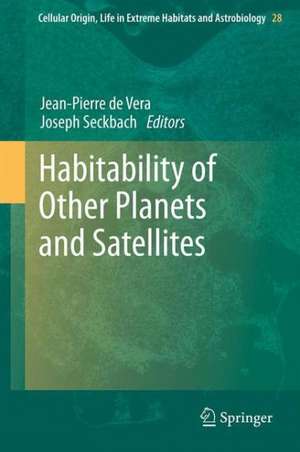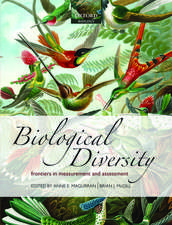Habitability of Other Planets and Satellites: Cellular Origin, Life in Extreme Habitats and Astrobiology, cartea 28
Editat de Jean-Pierre de Vera, Joseph Seckbachen Limba Engleză Hardback – 12 aug 2013
| Toate formatele și edițiile | Preț | Express |
|---|---|---|
| Paperback (1) | 1115.14 lei 6-8 săpt. | |
| SPRINGER NETHERLANDS – 7 aug 2015 | 1115.14 lei 6-8 săpt. | |
| Hardback (1) | 1122.58 lei 6-8 săpt. | |
| SPRINGER NETHERLANDS – 12 aug 2013 | 1122.58 lei 6-8 săpt. |
Din seria Cellular Origin, Life in Extreme Habitats and Astrobiology
- 18%
 Preț: 1683.66 lei
Preț: 1683.66 lei - 5%
 Preț: 1440.04 lei
Preț: 1440.04 lei - 18%
 Preț: 1839.32 lei
Preț: 1839.32 lei - 18%
 Preț: 1848.33 lei
Preț: 1848.33 lei - 18%
 Preț: 1839.32 lei
Preț: 1839.32 lei - 18%
 Preț: 1222.27 lei
Preț: 1222.27 lei - 18%
 Preț: 1232.26 lei
Preț: 1232.26 lei - 18%
 Preț: 2098.03 lei
Preț: 2098.03 lei - 18%
 Preț: 1228.29 lei
Preț: 1228.29 lei - 18%
 Preț: 2111.46 lei
Preț: 2111.46 lei - 24%
 Preț: 1076.36 lei
Preț: 1076.36 lei - 18%
 Preț: 1828.11 lei
Preț: 1828.11 lei - 18%
 Preț: 951.14 lei
Preț: 951.14 lei - 18%
 Preț: 1219.94 lei
Preț: 1219.94 lei - 18%
 Preț: 1235.08 lei
Preț: 1235.08 lei - 18%
 Preț: 1252.76 lei
Preț: 1252.76 lei - 18%
 Preț: 1263.01 lei
Preț: 1263.01 lei - 18%
 Preț: 956.50 lei
Preț: 956.50 lei - 18%
 Preț: 956.03 lei
Preț: 956.03 lei - 18%
 Preț: 1234.46 lei
Preț: 1234.46 lei - 15%
 Preț: 646.11 lei
Preț: 646.11 lei - 18%
 Preț: 1840.91 lei
Preț: 1840.91 lei - 18%
 Preț: 1231.16 lei
Preț: 1231.16 lei - 18%
 Preț: 1251.50 lei
Preț: 1251.50 lei - 18%
 Preț: 961.41 lei
Preț: 961.41 lei
Preț: 1122.58 lei
Preț vechi: 1369.00 lei
-18% Nou
Puncte Express: 1684
Preț estimativ în valută:
214.80€ • 224.27$ • 177.78£
214.80€ • 224.27$ • 177.78£
Carte tipărită la comandă
Livrare economică 04-18 aprilie
Preluare comenzi: 021 569.72.76
Specificații
ISBN-13: 9789400765450
ISBN-10: 9400765452
Pagini: 500
Ilustrații: XXIX, 419 p.
Dimensiuni: 155 x 235 x 25 mm
Greutate: 0.84 kg
Ediția:2013
Editura: SPRINGER NETHERLANDS
Colecția Springer
Seria Cellular Origin, Life in Extreme Habitats and Astrobiology
Locul publicării:Dordrecht, Netherlands
ISBN-10: 9400765452
Pagini: 500
Ilustrații: XXIX, 419 p.
Dimensiuni: 155 x 235 x 25 mm
Greutate: 0.84 kg
Ediția:2013
Editura: SPRINGER NETHERLANDS
Colecția Springer
Seria Cellular Origin, Life in Extreme Habitats and Astrobiology
Locul publicării:Dordrecht, Netherlands
Public țintă
Upper undergraduateCuprins
Foreword.- Preface.- Introduction.- List of Authors and Their Addresses.- Acknowledgements.- Part 1: PARAMETERS FOR HABITABILITY, HABITABLE ZONES AND LIFE: ENERGY, LIQUID SOLVENT, INFORMATION.- The Habitable Zone: Basic Concepts.- Exoplanets: Criteria for Their Habitability and Possible Biospheres.- The Habitable Zone and The Generalized Greenhouse Effect.- The Influence of UV Radiation on Exoplanets’ Habitability.- Factors of Planetary Habitability.- Bio-relevant microscopic liquid subsurface water in planetary surfaces?.- Part 2: IMPACT CRATERS AND THE EVOLUTION OF LIFE.- Organic molecules in lunar ice: a window to the early evolution of life on Earth.- Part 3: FIELD STUDIES IN PLANETARY ANALOGS, SIMULATIONS AND SPACE EXPERIMENTS WITH RELEVANCE TO HABITABILITY.- Experimental simulation of possible origins of life (Conceptual and Practical Issues).- Simulation and measurement of extraterrestrial conditions for experiments on habitability with respect to Mars.- The Role of Terrestrial Analogs in the Exploration of The Habitability of Martian Evaporitic Environments.- Part 4: SEARCH FOR HABITABLE WORLDS IN THE SOLAR SYSTEM AND BEYOND.- Microbial scale habitability on Mars.- Interior and surface dynamics of terrestrial bodies and their implications for the habitability.- Exoplanets and habitability.- Part 5: ALTERNATIVES TO EARTH-LIKE LIFE.- Extremophiles on Alien Worlds: What Types of Organismic Adaptations are Feasible on Other Planetary Bodies.- Brown Dwarfs and Black Smokers. The Potential for Photosynthesis using Radiation from Low-Temperature Black Bodies.- Part 6: APPLICATION OF EXISTING TECHNOLOGIES FOR THE DETECTION OF HABITABLE PLANETS AND THE SEARCH FOR LIFE.- Detection of Habitable Planets and The Search for Life.- Raman Spectral Signatures in the Biogeological Record: An Astrobiological Challenge.- Application of Raman Spectroscopy as In Situ Technology for the Search for Life.- Part 7:FUTURE SPACE MISSIONS FOR LIFE DETECTION.- Habitability on Kepler worlds: Are Moons Relevant?.- Clean In-Situ Subsurface Exploration of Icy Environments in the Solar System.- Part 8: SUMMARY AND CONCLUSIONS.- Theoretically possible habitable Worlds – but soon will we get answers by observations?.- Subject Index.- Author Index.
Recenzii
From the reviews:
“This edited collection of short papers covers a range of topics relevant to questions of habitability on planetary bodies other than Earth. … the book is perhaps suitable as a primer in aspects of astrobiology associated with questions of habitability of other planets and moons. … Summing Up: Recommended. Upper-division undergraduates and above.” (P. K. Strother, Choice, Vol. 51 (7), March, 2014)
“This edited collection of short papers covers a range of topics relevant to questions of habitability on planetary bodies other than Earth. … the book is perhaps suitable as a primer in aspects of astrobiology associated with questions of habitability of other planets and moons. … Summing Up: Recommended. Upper-division undergraduates and above.” (P. K. Strother, Choice, Vol. 51 (7), March, 2014)
Textul de pe ultima copertă
Is Earth the right model and therefore our Earth-centric view the only universal key to understand habitability, the origin and maintenance of life? This book tries to give answers on this question. It gives insights into the nature of planets and their potential to harbor life as well as the role of life itself as an engine to increase the habitability of planets and satellites. Knowledge of different disciplines in Astronomy, Biology, Chemistry, Geology, Planetology and Physics are the driving force for the discussion what might be the clues to classify a planetary body as a habitable object. The role of the atmosphere, solar radiation, magnetism, tectonics, mineral composition, liquid water availability and the interactions with life are in the focus of the general discussion. Earth serves as the reference system to get an approximation of the factors which might be important for classification of a celestial body as a habitable object. Results from field studies and those obtained from laboratory studies in planetary simulation facilities will help to elucidate if some of the planets and satellites in our solar system are potentially habitable for terrestrial life forms. The discussion is also enlarged in particular to exo-planets and their potential to be habitable. Further, recent technologies are presented in this book which might be suitable for remote or in situ identification of habitable environments and life as we know it. Instrumentation, detection devices, space projects and space mission designs to search for habitable niches and life is part of this work and gives insights into the challenges we might confront if we pursue the main task to detect life. The initial step of these exploration endeavors might be to discover first habitable environments and then to look after life forms with life detecting instrumentation in the discovered habitable niches.
Caracteristici
Dedicated chapter illustrating alternative life compared to our Earth-centric considerations New mission concepts for remote studying of habitability of exo-planets In situ investigations of the Polar Caps of Mars and the icy Moons of Jupiter and Saturn State of the art collection from experts in relevant fields Systematic approach to define habitability of planets













